Explaining the Postgres Query Optimizer
- 1. Explaining the Postgres Query Optimizer BRUCE MOMJIAN January, 2012 The optimizer is the "brain" of the database, interpreting SQL queries and determining the fastest method of execution. This talk uses the EXPLAIN command to show how the optimizer interprets queries and determines optimal execution. Creative Commons Attribution License http://momjian.us/presentations 1 / 56
- 2. Postgres Query Execution User Terminal Code Database Server Application Queries Results PostgreSQL Libpq Explaining the Postgres Query Optimizer 2 / 56
- 3. Postgres Query Execution Postgres Postgres utility Postmaster Parse Statement Traffic Cop Query Generate Paths Optimal Path Plan Libpq Main Generate Plan Execute Plan e.g. CREATE TABLE, COPY SELECT, INSERT, UPDATE, DELETE Rewrite Query Utility Command Utilities Catalog Storage Managers Access Methods Nodes / Lists Explaining the Postgres Query Optimizer 3 / 56
- 4. Postgres Query Execution utility Parse Statement Traffic Cop Query Generate Paths Optimal Path Generate Plan Plan Execute Plan e.g. CREATE TABLE, COPY SELECT, INSERT, UPDATE, DELETE Rewrite Query Utility Command Explaining the Postgres Query Optimizer 4 / 56
- 5. The Optimizer Is the Brain http://www.wsmanaging.com/ Explaining the Postgres Query Optimizer 5 / 56
- 6. What Decisions Does the Optimizer Have to Make? I Scan Method I Join Method I Join Order Explaining the Postgres Query Optimizer 6 / 56
- 7. Which Scan Method? I Sequential Scan I Bitmap Index Scan I Index Scan Explaining the Postgres Query Optimizer 7 / 56
- 8. A Simple Example Using pg_class.relname SELECT relname FROM pg_class ORDER BY 1 LIMIT 8; relname ----------------------------------- _pg_foreign_data_wrappers _pg_foreign_servers _pg_user_mappings administrable_role_authorizations applicable_roles attributes check_constraint_routine_usage check_constraints (8 rows) Explaining the Postgres Query Optimizer 8 / 56
- 9. Let’s Use Just the First Letter of pg_class.relname SELECT substring(relname, 1, 1) FROM pg_class ORDER BY 1 LIMIT 8; substring ----------- _ _ _ a a a c c (8 rows) Explaining the Postgres Query Optimizer 9 / 56
- 10. Create a Temporary Table with an Index CREATE TEMPORARY TABLE sample (letter, junk) AS SELECT substring(relname, 1, 1), repeat(’x’, 250) FROM pg_class ORDER BY random(); -- add rows in random order SELECT 253 CREATE INDEX i_sample on sample (letter); CREATE INDEX All the queries used in this presentation are available at http://momjian.us/main/writings/pgsql/optimizer.sql. Explaining the Postgres Query Optimizer 10 / 56
- 11. Create an EXPLAIN Function CREATE OR REPLACE FUNCTION lookup_letter(text) RETURNS SETOF text AS $$ BEGIN RETURN QUERY EXECUTE ’ EXPLAIN SELECT letter FROM sample WHERE letter = ’’’ || $1 || ’’’’; END $$ LANGUAGE plpgsql; CREATE FUNCTION Explaining the Postgres Query Optimizer 11 / 56
- 12. What is the Distribution of the sample Table? WITH letters (letter, count) AS ( SELECT letter, COUNT(*) FROM sample GROUP BY 1 ) SELECT letter, count, (count * 100.0 / (SUM(count) OVER ()))::numeric(4,1) AS "%" FROM letters ORDER BY 2 DESC; Explaining the Postgres Query Optimizer 12 / 56
- 13. What is the Distribution of the sample Table? letter | count | % --------+-------+------ p | 199 | 78.7 s | 9 | 3.6 c | 8 | 3.2 r | 7 | 2.8 t | 5 | 2.0 v | 4 | 1.6 f | 4 | 1.6 d | 4 | 1.6 u | 3 | 1.2 a | 3 | 1.2 _ | 3 | 1.2 e | 2 | 0.8 i | 1 | 0.4 k | 1 | 0.4 (14 rows) Explaining the Postgres Query Optimizer 13 / 56
- 14. Is the Distribution Important? EXPLAIN SELECT letter FROM sample WHERE letter = ’p’; QUERY PLAN ------------------------------------------------------------------------ Index Scan using i_sample on sample (cost=0.00..8.27 rows=1 width=32) Index Cond: (letter = ’p’::text) (2 rows) Explaining the Postgres Query Optimizer 14 / 56
- 15. Is the Distribution Important? EXPLAIN SELECT letter FROM sample WHERE letter = ’d’; QUERY PLAN ------------------------------------------------------------------------ Index Scan using i_sample on sample (cost=0.00..8.27 rows=1 width=32) Index Cond: (letter = ’d’::text) (2 rows) Explaining the Postgres Query Optimizer 15 / 56
- 16. Is the Distribution Important? EXPLAIN SELECT letter FROM sample WHERE letter = ’k’; QUERY PLAN ------------------------------------------------------------------------ Index Scan using i_sample on sample (cost=0.00..8.27 rows=1 width=32) Index Cond: (letter = ’k’::text) (2 rows) Explaining the Postgres Query Optimizer 16 / 56
- 17. Running ANALYZE Causes a Sequential Scan for a Common Value ANALYZE sample; ANALYZE EXPLAIN SELECT letter FROM sample WHERE letter = ’p’; QUERY PLAN --------------------------------------------------------- Seq Scan on sample (cost=0.00..13.16 rows=199 width=2) Filter: (letter = ’p’::text) (2 rows) Autovacuum cannot ANALYZE (or VACUUM) temporary tables because these tables are only visible to the creating session. Explaining the Postgres Query Optimizer 17 / 56
- 18. Sequential Scan D T A D A T A D A T A D A T A D A T A D A T A D A T A D A T A D A T A D T 8K Heap A A D A T A D A T A A Explaining the Postgres Query Optimizer 18 / 56
- 19. A Less Common Value Causes a Bitmap Heap Scan EXPLAIN SELECT letter FROM sample WHERE letter = ’d’; QUERY PLAN ----------------------------------------------------------------------- Bitmap Heap Scan on sample (cost=4.28..12.74 rows=4 width=2) Recheck Cond: (letter = ’d’::text) -> Bitmap Index Scan on i_sample (cost=0.00..4.28 rows=4 width=0) Index Cond: (letter = ’d’::text) (4 rows) Explaining the Postgres Query Optimizer 19 / 56
- 20. Bitmap Index Scan Combined Index 1 Table col1 = ’A’ col2 = ’NS’ 0 & = ’A’ AND ’NS’ 0 1 0 1 Index 2 1 Index 0 1 0 0 1 0 Explaining the Postgres Query Optimizer 20 / 56
- 21. An Even Rarer Value Causes an Index Scan EXPLAIN SELECT letter FROM sample WHERE letter = ’k’; QUERY PLAN ----------------------------------------------------------------------- Index Scan using i_sample on sample (cost=0.00..8.27 rows=1 width=2) Index Cond: (letter = ’k’::text) (2 rows) Explaining the Postgres Query Optimizer 21 / 56
- 22. Index Scan D A D A T A D A T A D A T A D A T A D A T A D A T A < Key = > < Key = > Index Heap < Key = > D A T A D A T A D A T A D A T A D A T A A T Explaining the Postgres Query Optimizer 22 / 56
- 23. Let’s Look at All Values and their Effects WITH letter (letter, count) AS ( SELECT letter, COUNT(*) FROM sample GROUP BY 1 ) SELECT letter AS l, count, lookup_letter(letter) FROM letter ORDER BY 2 DESC; l | count | lookup_letter ---+-------+----------------------------------------------------------------------- p | 199 | Seq Scan on sample (cost=0.00..13.16 rows=199 width=2) p | 199 | Filter: (letter = ’p’::text) s | 9 | Seq Scan on sample (cost=0.00..13.16 rows=9 width=2) s | 9 | Filter: (letter = ’s’::text) c | 8 | Seq Scan on sample (cost=0.00..13.16 rows=8 width=2) c | 8 | Filter: (letter = ’c’::text) r | 7 | Seq Scan on sample (cost=0.00..13.16 rows=7 width=2) r | 7 | Filter: (letter = ’r’::text) … Explaining the Postgres Query Optimizer 23 / 56
- 24. OK, Just the First Lines WITH letter (letter, count) AS ( SELECT letter, COUNT(*) FROM sample GROUP BY 1 ) SELECT letter AS l, count, (SELECT * FROM lookup_letter(letter) AS l2 LIMIT 1) AS lookup_letter FROM letter ORDER BY 2 DESC; Explaining the Postgres Query Optimizer 24 / 56
- 25. Just the First EXPLAIN Lines l | count | lookup_letter ---+-------+----------------------------------------------------------------------- p | 199 | Seq Scan on sample (cost=0.00..13.16 rows=199 width=2) s | 9 | Seq Scan on sample (cost=0.00..13.16 rows=9 width=2) c | 8 | Seq Scan on sample (cost=0.00..13.16 rows=8 width=2) r | 7 | Seq Scan on sample (cost=0.00..13.16 rows=7 width=2) t | 5 | Bitmap Heap Scan on sample (cost=4.29..12.76 rows=5 width=2) f | 4 | Bitmap Heap Scan on sample (cost=4.28..12.74 rows=4 width=2) v | 4 | Bitmap Heap Scan on sample (cost=4.28..12.74 rows=4 width=2) d | 4 | Bitmap Heap Scan on sample (cost=4.28..12.74 rows=4 width=2) a | 3 | Bitmap Heap Scan on sample (cost=4.27..11.38 rows=3 width=2) _ | 3 | Bitmap Heap Scan on sample (cost=4.27..11.38 rows=3 width=2) u | 3 | Bitmap Heap Scan on sample (cost=4.27..11.38 rows=3 width=2) e | 2 | Index Scan using i_sample on sample (cost=0.00..8.27 rows=1 width=2) i | 1 | Index Scan using i_sample on sample (cost=0.00..8.27 rows=1 width=2) k | 1 | Index Scan using i_sample on sample (cost=0.00..8.27 rows=1 width=2) (14 rows) Explaining the Postgres Query Optimizer 25 / 56
- 26. We Can Force an Index Scan SET enable_seqscan = false; SET enable_bitmapscan = false; WITH letter (letter, count) AS ( SELECT letter, COUNT(*) FROM sample GROUP BY 1 ) SELECT letter AS l, count, (SELECT * FROM lookup_letter(letter) AS l2 LIMIT 1) AS lookup_letter FROM letter ORDER BY 2 DESC; Explaining the Postgres Query Optimizer 26 / 56
- 27. Notice the High Cost for Common Values l | count | lookup_letter ---+-------+------------------------------------------------------------------------- p | 199 | Index Scan using i_sample on sample (cost=0.00..39.33 rows=199 width=2) s | 9 | Index Scan using i_sample on sample (cost=0.00..22.14 rows=9 width=2) c | 8 | Index Scan using i_sample on sample (cost=0.00..19.84 rows=8 width=2) r | 7 | Index Scan using i_sample on sample (cost=0.00..19.82 rows=7 width=2) t | 5 | Index Scan using i_sample on sample (cost=0.00..15.21 rows=5 width=2) d | 4 | Index Scan using i_sample on sample (cost=0.00..15.19 rows=4 width=2) v | 4 | Index Scan using i_sample on sample (cost=0.00..15.19 rows=4 width=2) f | 4 | Index Scan using i_sample on sample (cost=0.00..15.19 rows=4 width=2) _ | 3 | Index Scan using i_sample on sample (cost=0.00..12.88 rows=3 width=2) a | 3 | Index Scan using i_sample on sample (cost=0.00..12.88 rows=3 width=2) u | 3 | Index Scan using i_sample on sample (cost=0.00..12.88 rows=3 width=2) e | 2 | Index Scan using i_sample on sample (cost=0.00..8.27 rows=1 width=2) i | 1 | Index Scan using i_sample on sample (cost=0.00..8.27 rows=1 width=2) k | 1 | Index Scan using i_sample on sample (cost=0.00..8.27 rows=1 width=2) (14 rows) RESET ALL; RESET Explaining the Postgres Query Optimizer 27 / 56
- 28. This Was the Optimizer’s Preference l | count | lookup_letter ---+-------+----------------------------------------------------------------------- p | 199 | Seq Scan on sample (cost=0.00..13.16 rows=199 width=2) s | 9 | Seq Scan on sample (cost=0.00..13.16 rows=9 width=2) c | 8 | Seq Scan on sample (cost=0.00..13.16 rows=8 width=2) r | 7 | Seq Scan on sample (cost=0.00..13.16 rows=7 width=2) t | 5 | Bitmap Heap Scan on sample (cost=4.29..12.76 rows=5 width=2) f | 4 | Bitmap Heap Scan on sample (cost=4.28..12.74 rows=4 width=2) v | 4 | Bitmap Heap Scan on sample (cost=4.28..12.74 rows=4 width=2) d | 4 | Bitmap Heap Scan on sample (cost=4.28..12.74 rows=4 width=2) a | 3 | Bitmap Heap Scan on sample (cost=4.27..11.38 rows=3 width=2) _ | 3 | Bitmap Heap Scan on sample (cost=4.27..11.38 rows=3 width=2) u | 3 | Bitmap Heap Scan on sample (cost=4.27..11.38 rows=3 width=2) e | 2 | Index Scan using i_sample on sample (cost=0.00..8.27 rows=1 width=2) i | 1 | Index Scan using i_sample on sample (cost=0.00..8.27 rows=1 width=2) k | 1 | Index Scan using i_sample on sample (cost=0.00..8.27 rows=1 width=2) (14 rows) Explaining the Postgres Query Optimizer 28 / 56
- 29. Which Join Method? I Nested Loop I With Inner Sequential Scan I With Inner Index Scan I Hash Join I Merge Join Explaining the Postgres Query Optimizer 29 / 56
- 30. What Is in pg_proc.oid? SELECT oid FROM pg_proc ORDER BY 1 LIMIT 8; oid ----- 31 33 34 35 38 39 40 41 (8 rows) Explaining the Postgres Query Optimizer 30 / 56
- 31. Create Temporary Tables from pg_proc and pg_class CREATE TEMPORARY TABLE sample1 (id, junk) AS SELECT oid, repeat(’x’, 250) FROM pg_proc ORDER BY random(); -- add rows in random order SELECT 2256 CREATE TEMPORARY TABLE sample2 (id, junk) AS SELECT oid, repeat(’x’, 250) FROM pg_class ORDER BY random(); -- add rows in random order SELECT 260 These tables have no indexes and no optimizer statistics. Explaining the Postgres Query Optimizer 31 / 56
- 32. Join the Two Tables with a Tight Restriction EXPLAIN SELECT sample2.junk FROM sample1 JOIN sample2 ON (sample1.id = sample2.id) WHERE sample1.id = 33; QUERY PLAN --------------------------------------------------------------------- Nested Loop (cost=0.00..234.68 rows=300 width=32) -> Seq Scan on sample1 (cost=0.00..205.54 rows=50 width=4) Filter: (id = 33::oid) -> Materialize (cost=0.00..25.41 rows=6 width=36) -> Seq Scan on sample2 (cost=0.00..25.38 rows=6 width=36) Filter: (id = 33::oid) (6 rows) Explaining the Postgres Query Optimizer 32 / 56
- 33. Nested Loop Join with Inner Sequential Scan Outer Inner aag aai aay aag aar aas aar aay aaa aag No Setup Required aai Used For Small Tables Explaining the Postgres Query Optimizer 33 / 56
- 34. Pseudocode for Nested Loop Join with Inner Sequential Scan for (i = 0; i < length(outer); i++) for (j = 0; j < length(inner); j++) if (outer[i] == inner[j]) output(outer[i], inner[j]); Explaining the Postgres Query Optimizer 34 / 56
- 35. Join the Two Tables with a Looser Restriction EXPLAIN SELECT sample1.junk FROM sample1 JOIN sample2 ON (sample1.id = sample2.id) WHERE sample2.id > 33; QUERY PLAN ---------------------------------------------------------------------- Hash Join (cost=30.50..950.88 rows=20424 width=32) Hash Cond: (sample1.id = sample2.id) -> Seq Scan on sample1 (cost=0.00..180.63 rows=9963 width=36) -> Hash (cost=25.38..25.38 rows=410 width=4) -> Seq Scan on sample2 (cost=0.00..25.38 rows=410 width=4) Filter: (id > 33::oid) (6 rows) Explaining the Postgres Query Optimizer 35 / 56
- 36. Hash Join Hashed Must fit in Main Memory aak aar aak aam aay aar aao aaw aay aag aas Outer Inner Explaining the Postgres Query Optimizer 36 / 56
- 37. Pseudocode for Hash Join for (j = 0; j < length(inner); j++) hash_key = hash(inner[j]); append(hash_store[hash_key], inner[j]); for (i = 0; i < length(outer); i++) hash_key = hash(outer[i]); for (j = 0; j < length(hash_store[hash_key]); j++) if (outer[i] == hash_store[hash_key][j]) output(outer[i], inner[j]); Explaining the Postgres Query Optimizer 37 / 56
- 38. Join the Two Tables with No Restriction EXPLAIN SELECT sample1.junk FROM sample1 JOIN sample2 ON (sample1.id = sample2.id); QUERY PLAN ------------------------------------------------------------------------- Merge Join (cost=927.72..1852.95 rows=61272 width=32) Merge Cond: (sample2.id = sample1.id) -> Sort (cost=85.43..88.50 rows=1230 width=4) Sort Key: sample2.id -> Seq Scan on sample2 (cost=0.00..22.30 rows=1230 width=4) -> Sort (cost=842.29..867.20 rows=9963 width=36) Sort Key: sample1.id -> Seq Scan on sample1 (cost=0.00..180.63 rows=9963 width=36) (8 rows) Explaining the Postgres Query Optimizer 38 / 56
- 39. Merge Join Sorted Sorted Outer Inner aaa aab aac aad aaa aab aab aac aae aaf aaf Ideal for Large Tables An Index Can Be Used to Eliminate the Sort Explaining the Postgres Query Optimizer 39 / 56
- 40. Pseudocode for Merge Join sort(outer); sort(inner); i = 0; j = 0; save_j = 0; while (i < length(outer)) if (outer[i] == inner[j]) output(outer[i], inner[j]); if (outer[i] <= inner[j] && j < length(inner)) j++; if (outer[i] < inner[j]) save_j = j; else i++; j = save_j; Explaining the Postgres Query Optimizer 40 / 56
- 41. Order of Joined Relations Is Insignificant EXPLAIN SELECT sample2.junk FROM sample2 JOIN sample1 ON (sample2.id = sample1.id); QUERY PLAN ------------------------------------------------------------------------ Merge Join (cost=927.72..1852.95 rows=61272 width=32) Merge Cond: (sample2.id = sample1.id) -> Sort (cost=85.43..88.50 rows=1230 width=36) Sort Key: sample2.id -> Seq Scan on sample2 (cost=0.00..22.30 rows=1230 width=36) -> Sort (cost=842.29..867.20 rows=9963 width=4) Sort Key: sample1.id -> Seq Scan on sample1 (cost=0.00..180.63 rows=9963 width=4) (8 rows) The most restrictive relation, e.g. sample2, is always on the outer side of merge joins. All previous merge joins also had sample2 in outer position. Explaining the Postgres Query Optimizer 41 / 56
- 42. Add Optimizer Statistics ANALYZE sample1; ANALYZE sample2; Explaining the Postgres Query Optimizer 42 / 56
- 43. This Was a Merge Join without Optimizer Statistics EXPLAIN SELECT sample2.junk FROM sample1 JOIN sample2 ON (sample1.id = sample2.id); QUERY PLAN ------------------------------------------------------------------------ Hash Join (cost=15.85..130.47 rows=260 width=254) Hash Cond: (sample1.id = sample2.id) -> Seq Scan on sample1 (cost=0.00..103.56 rows=2256 width=4) -> Hash (cost=12.60..12.60 rows=260 width=258) -> Seq Scan on sample2 (cost=0.00..12.60 rows=260 width=258) (5 rows) Explaining the Postgres Query Optimizer 43 / 56
- 44. Outer Joins Can Affect Optimizer Join Usage EXPLAIN SELECT sample1.junk FROM sample1 RIGHT OUTER JOIN sample2 ON (sample1.id = sample2.id); QUERY PLAN -------------------------------------------------------------------------- Hash Left Join (cost=131.76..148.26 rows=260 width=254) Hash Cond: (sample2.id = sample1.id) -> Seq Scan on sample2 (cost=0.00..12.60 rows=260 width=4) -> Hash (cost=103.56..103.56 rows=2256 width=258) -> Seq Scan on sample1 (cost=0.00..103.56 rows=2256 width=258) (5 rows) Use of hashes for outer joins was added in Postgres 9.1. Explaining the Postgres Query Optimizer 44 / 56
- 45. Cross Joins Are Nested Loop Joins without Join Restriction EXPLAIN SELECT sample1.junk FROM sample1 CROSS JOIN sample2; QUERY PLAN ---------------------------------------------------------------------- Nested Loop (cost=0.00..7448.81 rows=586560 width=254) -> Seq Scan on sample1 (cost=0.00..103.56 rows=2256 width=254) -> Materialize (cost=0.00..13.90 rows=260 width=0) -> Seq Scan on sample2 (cost=0.00..12.60 rows=260 width=0) (4 rows) Explaining the Postgres Query Optimizer 45 / 56
- 46. Create Indexes CREATE INDEX i_sample1 on sample1 (id); CREATE INDEX i_sample2 on sample2 (id); Explaining the Postgres Query Optimizer 46 / 56
- 47. Nested Loop with Inner Index Scan Now Possible EXPLAIN SELECT sample2.junk FROM sample1 JOIN sample2 ON (sample1.id = sample2.id) WHERE sample1.id = 33; QUERY PLAN --------------------------------------------------------------------------------- Nested Loop (cost=0.00..16.55 rows=1 width=254) -> Index Scan using i_sample1 on sample1 (cost=0.00..8.27 rows=1 width=4) Index Cond: (id = 33::oid) -> Index Scan using i_sample2 on sample2 (cost=0.00..8.27 rows=1 width=258) Index Cond: (sample2.id = 33::oid) (5 rows) Explaining the Postgres Query Optimizer 47 / 56
- 48. Nested Loop Join with Inner Index Scan Outer Inner aag aai aay aag aar aai aas aar aay aaa aag Index Lookup No Setup Required Index Must Already Exist Explaining the Postgres Query Optimizer 48 / 56
- 49. Pseudocode for Nested Loop Join with Inner Index Scan for (i = 0; i < length(outer); i++) index_entry = get_first_match(outer[j]) while (index_entry) output(outer[i], inner[index_entry]); index_entry = get_next_match(index_entry); Explaining the Postgres Query Optimizer 49 / 56
- 50. Query Restrictions Affect Join Usage EXPLAIN SELECT sample2.junk FROM sample1 JOIN sample2 ON (sample1.id = sample2.id) WHERE sample2.junk ˜ ’^aaa’; QUERY PLAN ------------------------------------------------------------------------------- Nested Loop (cost=0.00..21.53 rows=1 width=254) -> Seq Scan on sample2 (cost=0.00..13.25 rows=1 width=258) Filter: (junk ˜ ’^aaa’::text) -> Index Scan using i_sample1 on sample1 (cost=0.00..8.27 rows=1 width=4) Index Cond: (sample1.id = sample2.id) (5 rows) No junk rows begin with ’aaa’. Explaining the Postgres Query Optimizer 50 / 56
- 51. All ’junk’ Columns Begin with ’xxx’ EXPLAIN SELECT sample2.junk FROM sample1 JOIN sample2 ON (sample1.id = sample2.id) WHERE sample2.junk ˜ ’^xxx’; QUERY PLAN ------------------------------------------------------------------------ Hash Join (cost=16.50..131.12 rows=260 width=254) Hash Cond: (sample1.id = sample2.id) -> Seq Scan on sample1 (cost=0.00..103.56 rows=2256 width=4) -> Hash (cost=13.25..13.25 rows=260 width=258) -> Seq Scan on sample2 (cost=0.00..13.25 rows=260 width=258) Filter: (junk ˜ ’^xxx’::text) (6 rows) Hash join was chosen because many more rows are expected. The smaller table, e.g. sample2, is always hashed. Explaining the Postgres Query Optimizer 51 / 56
- 52. Without LIMIT, Hash Is Used for this Unrestricted Join EXPLAIN SELECT sample2.junk FROM sample1 JOIN sample2 ON (sample1.id = sample2.id); QUERY PLAN ------------------------------------------------------------------------ Hash Join (cost=15.85..130.47 rows=260 width=254) Hash Cond: (sample1.id = sample2.id) -> Seq Scan on sample1 (cost=0.00..103.56 rows=2256 width=4) -> Hash (cost=12.60..12.60 rows=260 width=258) -> Seq Scan on sample2 (cost=0.00..12.60 rows=260 width=258) (5 rows) Explaining the Postgres Query Optimizer 52 / 56
- 53. LIMIT Can Affect Join Usage EXPLAIN SELECT sample2.id, sample2.junk FROM sample1 JOIN sample2 ON (sample1.id = sample2.id) ORDER BY 1 LIMIT 1; QUERY PLAN ------------------------------------------------------------------------------------------ Limit (cost=0.00..1.83 rows=1 width=258) -> Nested Loop (cost=0.00..477.02 rows=260 width=258) -> Index Scan using i_sample2 on sample2 (cost=0.00..52.15 rows=260 width=258) -> Index Scan using i_sample1 on sample1 (cost=0.00..1.62 rows=1 width=4) Index Cond: (sample1.id = sample2.id) (5 rows) Explaining the Postgres Query Optimizer 53 / 56
- 54. LIMIT 10 EXPLAIN SELECT sample2.id, sample2.junk FROM sample1 JOIN sample2 ON (sample1.id = sample2.id) ORDER BY 1 LIMIT 10; QUERY PLAN ------------------------------------------------------------------------------------------ Limit (cost=0.00..18.35 rows=10 width=258) -> Nested Loop (cost=0.00..477.02 rows=260 width=258) -> Index Scan using i_sample2 on sample2 (cost=0.00..52.15 rows=260 width=258) -> Index Scan using i_sample1 on sample1 (cost=0.00..1.62 rows=1 width=4) Index Cond: (sample1.id = sample2.id) (5 rows) Explaining the Postgres Query Optimizer 54 / 56
- 55. LIMIT 100 Switches to Hash Join EXPLAIN SELECT sample2.id, sample2.junk FROM sample1 JOIN sample2 ON (sample1.id = sample2.id) ORDER BY 1 LIMIT 100; QUERY PLAN ------------------------------------------------------------------------------------ Limit (cost=140.41..140.66 rows=100 width=258) -> Sort (cost=140.41..141.06 rows=260 width=258) Sort Key: sample2.id -> Hash Join (cost=15.85..130.47 rows=260 width=258) Hash Cond: (sample1.id = sample2.id) -> Seq Scan on sample1 (cost=0.00..103.56 rows=2256 width=4) -> Hash (cost=12.60..12.60 rows=260 width=258) -> Seq Scan on sample2 (cost=0.00..12.60 rows=260 width=258) (8 rows) Explaining the Postgres Query Optimizer 55 / 56
- 56. Conclusion http://momjian.us/presentations http://www.vivapixel.com/photo/14252 Explaining the Postgres Query Optimizer 56 / 56




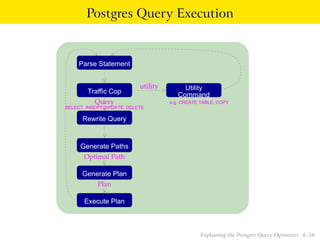

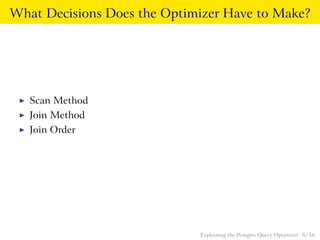



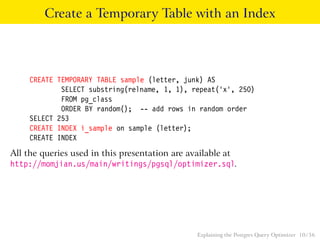





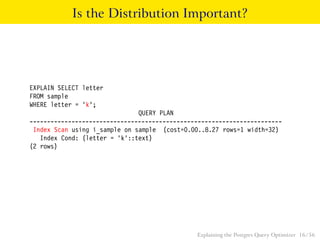


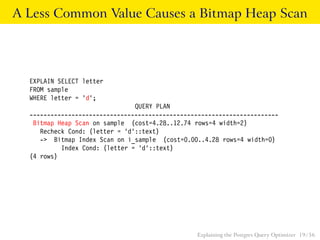




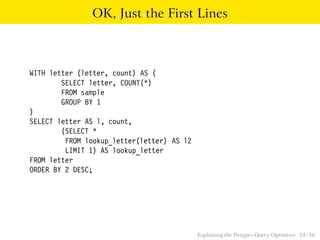









![Pseudocode for Nested Loop Join
with Inner Sequential Scan
for (i = 0; i < length(outer); i++)
for (j = 0; j < length(inner); j++)
if (outer[i] == inner[j])
output(outer[i], inner[j]);
Explaining the Postgres Query Optimizer 34 / 56](https://image.slidesharecdn.com/postgresoptmizer-momjian-140923125617-phpapp01/85/Explaining-the-Postgres-Query-Optimizer-34-320.jpg)


![Pseudocode for Hash Join
for (j = 0; j < length(inner); j++)
hash_key = hash(inner[j]);
append(hash_store[hash_key], inner[j]);
for (i = 0; i < length(outer); i++)
hash_key = hash(outer[i]);
for (j = 0; j < length(hash_store[hash_key]); j++)
if (outer[i] == hash_store[hash_key][j])
output(outer[i], inner[j]);
Explaining the Postgres Query Optimizer 37 / 56](https://image.slidesharecdn.com/postgresoptmizer-momjian-140923125617-phpapp01/85/Explaining-the-Postgres-Query-Optimizer-37-320.jpg)


![Pseudocode for Merge Join
sort(outer);
sort(inner);
i = 0;
j = 0;
save_j = 0;
while (i < length(outer))
if (outer[i] == inner[j])
output(outer[i], inner[j]);
if (outer[i] <= inner[j] && j < length(inner))
j++;
if (outer[i] < inner[j])
save_j = j;
else
i++;
j = save_j;
Explaining the Postgres Query Optimizer 40 / 56](https://image.slidesharecdn.com/postgresoptmizer-momjian-140923125617-phpapp01/85/Explaining-the-Postgres-Query-Optimizer-40-320.jpg)







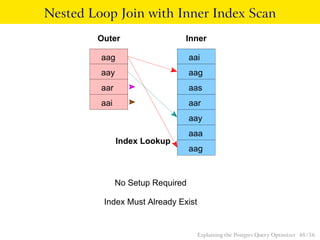
![Pseudocode for Nested Loop Join
with Inner Index Scan
for (i = 0; i < length(outer); i++)
index_entry = get_first_match(outer[j])
while (index_entry)
output(outer[i], inner[index_entry]);
index_entry = get_next_match(index_entry);
Explaining the Postgres Query Optimizer 49 / 56](https://image.slidesharecdn.com/postgresoptmizer-momjian-140923125617-phpapp01/85/Explaining-the-Postgres-Query-Optimizer-49-320.jpg)






